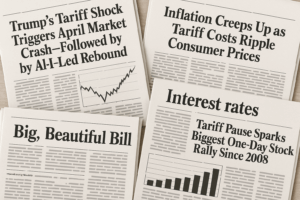
A Private Markets Primer: Understanding the Latest Wall Street Craze
Investment ManagementMar 28, 2025
Private markets are all the rage these days on Wall Street. Private equity, private credit, and even venture capital are now being rolled out to the masses. Think of this shift like the investing equivalent of the velvet rope to the VIP section being lifted for everyone. More people than ever can enter this formerly closed off area that has long been exclusive to only the large institutions and wealthiest individuals. As the Wall Street marketing machine ramps up, we must understand what private markets are, why they have become so popular, and why they carry unique risks and rewards. As we often say, when it comes to investing, there is no such thing as a free lunch.
First, let’s clearly define a few terms and demystify some financial jargon. Public markets are where stocks and bonds trade on exchanges like the New York Stock Exchange. These are the tickers you see across the bottom of the TV when you turn on financial news. They’re liquid, meaning easily sold for cash, and regulated. Exchanges and public markets more broadly allow investors the ability to buy and sell their holdings freely. Technology has made this easier than ever.
Private markets, on the other hand, involve investments that aren’t publicly traded. This can be in the form of things like private equity (buying ownership in privately owned businesses), private credit (lending money to privately owned businesses), and venture capital (providing funding to start-up companies). Private investments are less liquid, harder to value, and have historically been harder to access for the average investor for a number of reasons. Yet, they have also been the source of massive wealth creation.
There are a few reasons why private assets are the Wall Street equivalent of the “cool kid’s table” in the cafeteria these days. Since the 2008 financial crisis, private credit has filled a gap left by banks that scaled back commercial lending due to tighter regulations. At the same time, a decade-plus of low interest rates made it easier for investors to borrow money and buy privately owned companies. Companies have also been able to grow and scale up without needing to go public to access funding as they often did in the past. Additionally, a huge influx of capital from pension funds, sovereign wealth funds, and other sophisticated investors has driven the growth of private markets as they aimed for higher returns in a low-interest rate environment. These factors (and many others) combined to make private markets a really interesting place to be in recent years.
Now, big traditional Wall Street firms and newer platforms are aiming to capitalize on this by making private asset classes accessible for more investors. These investments can be low correlated diversification tools- meaning they should behave differently than the other parts of a portfolio. They also have the potential for high returns.
There are also a lot of unknowns in terms of how this will play out. Information about private companies is often limited, making it tough to know what you’re actually buying. Liquidity is also limited. In other words, selling your stake might not be easy or quick. It’s important to remember that private asset prices don’t move daily like those tickers we see on TV, but that definitely doesn’t mean they’re safer or less risky. The lack of daily price movement compared to the action in the public markets might give the illusion of stability, but this can mask underlying risks that only come to light when liquidity is needed or a private investment faces challenges.
Private equity and private credit have grown into massive asset classes worth trillions of dollars. While private markets are being hyped as the next big thing for everyday investors, it’s critical to understand the trade-offs. High fees, complexity related to taxes, and the fact that you are often locking up your capital for a long period of time can all be very different from what public market investors are accustomed to. In short, these products aren’t for everyone.
Competition is also more intense than ever. There are more private funds out there searching for deals and paying higher prices to complete them. The cost of capital has gone up with interest rates. Will these factors impact future investment returns? The eye-popping returns many investors came to expect in private assets during the low-interest rate environment from 2009 to 2021 are no sure thing to continue. McKinsey’s annual report on private markets put it well: we may be entering “a slower era.”
History has repeatedly shown that “the flashy new thing” can lead to too much risk-taking. While these are not apples-to-apples comparisons, the voracious appetite investors had for tech stocks in the late 90s, mortgage bonds in the early 2000s, and the darling stocks and SPACs of the pandemic more recently are all examples of the flashy new things that eventually got taken too far. As the Wall Street marketing machine ramps up to pitch private asset products to more individual investors, so does the risk of history repeating itself.
Private assets are the hot new thing but understanding them requires the same level of scrutiny and diligence as any other investment (maybe more?). No matter how the investment landscape continues to evolve, balancing financial innovation and new opportunities with being methodical and disciplined will always pay off in the long run. Building wealth doesn’t come from jumping on every new trend blindly, but by understanding what tools fit your specific situation and deploying them in a way that works for you.
Citations:
Want to Invest in a Private Company Like SpaceX? All It Takes Is $5,000, Imani Moise, Wall Street Journal- March 25, 2025
Private markets: A slower era, McKinsey Global Private Markets Review 2024
Advisors Want In On Private Credit. Should They?, The Daily Upside- February 23, 2025
It is important to remember that investments in securities involve risk, including the potential loss of principal invested. Investing in private markets involves a high degree of risk, including the potential loss of principal invested and lack of liquidity. Past performance is no guarantee of future results. Diversification does not guarantee a profit or protect against loss in a declining financial market. This publication should not be interpreted as legal, tax, or investment advice. For more information, please visit alliancewealthadvisors.com/legal-disclosures


